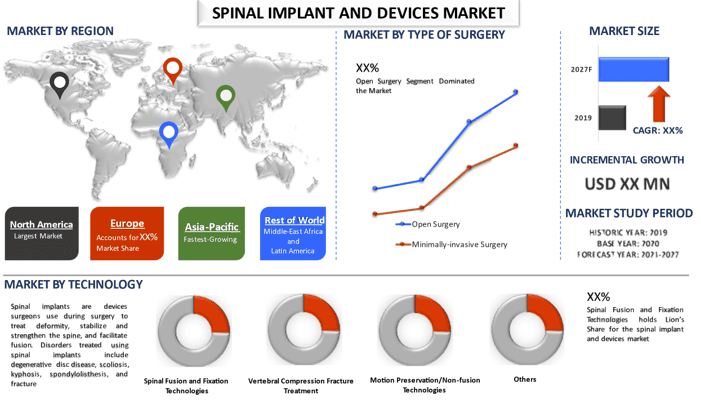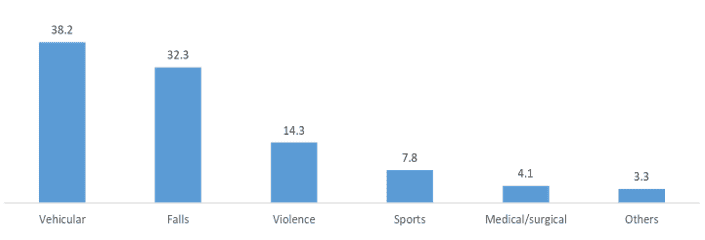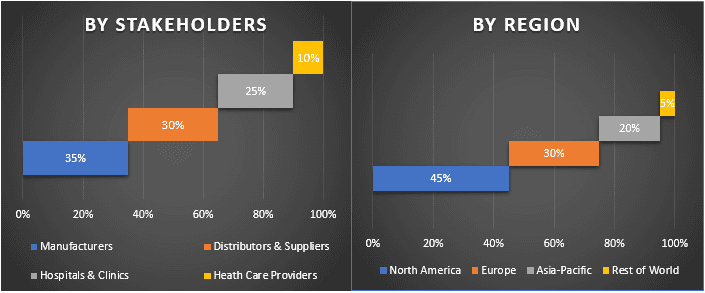- Home
- About Us
- Industry
- Services
- Reading
- Contact Us
Spinal Implant and Devices Market: Current Analysis and Forecast (2021-2027)
Emphasis on Product Type (Thoracic Fusion And Lumbar Fusion Devices, Cervical Fusion Devices, Spine Biologics, Non-Fusion Devices, Vertebral Compression Fracture Treatment Devices, Spine Bone Stimulators, Others); Type of Surgery (Open Surgeries, Minimally Invasive Surgeries); Technology (Spinal Fusion And Fixation, Vertebral Compression Fracture Treatment, Motion Preservation/Non-Fusion, Others); Application (Spinal Fusion and Fixation Technologies, Vertebral Compression Fracture Treatment, Motion Preservation/Non-fusion Technologies, Others); Region/Country

Global Spinal Implant and Devices Market was valued at approximately US$ 11.36 billion in 2020 and is anticipated to grow at a CAGR of around 5.3% over the forecast period (2021-2027). Spinal implants are devices surgeons use during surgery to treat deformity, stabilize, and strengthen the spine, and facilitate fusion. Disorders treated using spinal implants include degenerative disc disease, scoliosis, kyphosis, spondylolisthesis, and fracture. The spinal implants can be made from different materials such as titanium, titanium-alloy, stainless steel, and plastics. Surgeons and medical professionals across the globe prefer Titanium implants because of the superior properties of the titanium. Titanium is strong and lightweight and is a durable element and can be imaged using MRI (magnetic resonance imaging). Surgery Devices are produced in different sizes and shapes and some, such as they can be contoured during surgery to fit the patient’s anatomy. Many implants, such as cervical plates, are low profile meaning they are not bulky and lay flatter against the spine’s anatomy. Pedicle screws may be coated with a material to stimulate fusion.
The growth of this market is driven owing to advancements in spine surgery technologies, increasing incidence of spinal disorders, the launch of advanced bone grafting products, and the increasing adoption of minimally invasive spine surgeries. For instance, In August 2019, Mantiz a South Korean specialist producer of spinal implants entered a partnership with Shining 3D Tech. Co. to use Shining 3D machines to produce medical implants. In addition to this, In 2017, Aesculab launched the lumbar artificial disc replacement, the activL Artificial Disc, which is now available at several hospitals. It is the next evolution of artificial discs, as it has an extra dimension of motion, which is not found in any other product in the market. With this latest generation disc available in the United States, spine surgeons believe they can cost-effectively provide artificial disc replacement to patients, making travelling overseas for surgery unnecessary.Percentage distribution of spinal cord injuries in the United States between 2015 and 2020, By Cause

This statistic depicts the causes of spinal cord injuries between 2015 and 2020 in the United States. Since 2015, vehicular accidents were the cause of 38.2 percent of spinal cord injuries.
Researchers have estimated that, as of 2019, 17,730 new Spinal Cord Injuries (SCI) cases occur each year and between 249,000 and 363,000 people are currently living with SCI in the United States.
The majority of spinal cord injuries are due to preventable causes such as road traffic crashes, falls or violence. People with a spinal cord injury are two to five times more likely to die prematurely than people without a spinal cord injury, with worse survival rates in low- and middle-income countries.
Medtronic, DePuy Synthes, NuVasive, Inc., Stryker Corporation, B. Braun Melsungen AG, Abbott Laboratories, Boston Scientific, Zimmer Biomet Holdings, Inc., Globus Medical, Inc. and Orthofix International N.V. are some of the prominent players operating in the global spinal implant and devices market. Several M&A’s along with partnerships have been undertaken by these players to develop new and advanced products.
Insights Presented in the Report
“Amongst product type, thoracic fusion and lumbar fusion devices segment holds the major share”
On the basis of product type, the global spinal implant and devices market is segregated into thoracic fusion and lumbar fusion devices, cervical fusion devices, spine biologics, non-fusion devices, vertebral compression fracture treatment devices, spine bone stimulators, and others. The thoracic fusion and lumbar fusion devices segment accounted for the largest share of the spinal implants and surgery devices market in 2020. The large share of this segment can be attributed to the increasing incidence of lumbar degenerative disc disease and the growing number of product launches.
“Amongst type of surgery, open surgeries segment holds the major share”
Based on type of surgery, the spinal implants and surgery devices market is bifurcated into open surgeries and minimally invasive surgeries. The open surgeries segment accounted for the largest share of the spinal implants and surgery devices market in 2020. The large share of this segment can be attributed to the increasing preference for open spine surgeries among medical professionals, rising incidence of spinal deformities, and technological advancements in spinal fusion surgeries. In addition, advancement in augmented and virtual reality, endoscopic surgery and 3D printed implants for minimally invasive surgery is also expected to fuel the market growth.
“Amongst technology, the spinal fusion and fixation technologies segment holds the major share”
Depending on technology, the spinal implants and surgery devices market is segmented into spinal fusion and fixation, vertebral compression fracture treatment, motion preservation/non-fusion, and others. Out of which, the spinal fusion and fixation technologies segment accounted for the largest share of the spinal implants and surgery devices market in 2020. The large share of this segment can be attributed to the rising incidence of target diseases (such as degenerative disc disease and spinal stenosis) with the growing geriatric population across the globe, a growing number of spinal fusion procedures, and technological advancements in spinal fusion techniques and bone grafting procedures.
Amongst end user, the hospitals & clinics segment is projected to show fastest growth”
“North America signifies one of the largest markets of Spinal Implant and Devices market”
For a better understanding of the market dynamics of the spinal implant and devices market, a detailed analysis was conducted for different regions across the globe including North America (United States, Canada, and the Rest of North America), Europe (Germany, France, Italy, Spain, United Kingdom and Rest of Europe), Asia-Pacific (China, Japan, India, South Korea, and Rest of APAC), Rest of World has been conducted. North America is expected to dominate the spinal implant and devices market due to strong presence of well-developed healthcare infrastructure and rise in the government funding to support research and development for spine treatment. However, Asia-Pacific is expected to expand at a significant growth rate over the forecast period because of the developing healthcare infrastructure, increase in the ageing population and the presence of a large patient population.
Reasons to buy this report:
- The study includes market sizing and forecasting analysis validated by authenticated key industry experts
- The report presents a quick review of overall industry performance at one glance
- The report covers an in-depth analysis of prominent industry peers with a primary focus on key business financials, product portfolio, expansion strategies, and recent developments
- Detailed examination of drivers, restraints, key trends, and opportunities prevailing in the industry
- The study comprehensively covers the market across different segments
- Deep dive regional level analysis of the industry
Customization Options:
The Spinal Implant and Devices market can further be customized as per the requirement or any other market segment. Besides this, UMI understands that you may have your own business needs, hence feel free to connect with us to get a report that completely suits your requirements.
Table of Content
Analyzing the historical market, estimation of the current market, and forecasting the future market of the Global Spinal Implant and Devices market were the three major steps undertaken to create and analyze the adoption of spinal implant and devices amongst population across major regions globally. Exhaustive secondary research was conducted to collect the historical market numbers and estimate the current market size. Secondly, to validate these insights, numerous findings and assumptions were taken into consideration. Moreover, exhaustive primary interviews were also conducted, with industry experts across the value chain of spinal implant and devices. Post assumption and validation of market numbers through primary interviews, we employed a top-down approach to forecast the complete market size. Thereafter, market breakdown and data triangulation methods were adopted to estimate and analyze the market size of segments and sub-segments the industry pertains to. Detailed methodology is explained below:
Analysis of Historical Market Size
Step 1: In-Depth Study of Secondary Sources:
Detailed secondary study was conducted to obtain the historical market size of the Spinal Implant and Devices market through company internal sources such as annual report & financial statements, performance presentations, press releases, etc., and external sources including journals, news & articles, government publications, competitor publications, sector reports, third-party database, and other credible publications.
Step 2: Market Segmentation:
After obtaining the historical market size of the spinal implant and devices market, we conducted a detailed secondary analysis to gather historical market insights and share for different segments for major regions. Major segments included in the report are product type, type of surgery and technology. Further country-level analyses were conducted to evaluate the overall utilization of Spinal Implant and Devices in every region.
Step 3: Factor Analysis:
After acquiring the historical market size of different segments and sub-segments, we conducted a detailed factor analysis to estimate the current market size of Spinal Implant and Devices market. Further, we conducted factor analysis using dependent and independent variables such as advancements in spine surgery technologies. A thorough analysis was conducted for demand and supply-side scenario considering top partnerships, merger and acquisition, business expansion, and product launches in the Spinal Implant and Devices industry across the globe.
Current Market Size Estimate & Forecast
Current Market Sizing: Based on actionable insights from the above 3 steps, we arrived at the current market size, key players in the spinal implant and devices market, and market shares of the segments. All the required percentage shares split, and market breakdowns were determined using the above-mentioned secondary approach and were verified through primary interviews.
Estimation & Forecasting: For market estimation and forecast, weights were assigned to different factors including drivers & trends, restraints, and opportunities available for the stakeholders. After analyzing these factors, relevant forecasting techniques i.e. top-down/bottom-up approach was applied to arrive at the market forecast about 2027 for different segments and subsegments across the major markets globally. The research methodology adopted to estimate the market size encompasses:
- The industry’s market size, in terms of value (USD) and the utilization rate of Spinal Implant and Devices across the major markets domestically
- All percentage shares, splits, and breakdowns of market segments and sub-segments
- Key players in the spinal implant and devices market in terms of services offered. Also, the growth strategies adopted by these players to compete in the fast-growing market
Market Size and Share Validation
Primary Research: In-depth interviews were conducted with the Key Opinion Leaders (KOLs) including Top Level Executives (CXO/VPs, Sales Head, Marketing Head, Operational Head, and Regional Head, Country Head, etc.) across major regions. Primary research findings were then summarized, and statistical analysis was performed to prove the stated hypothesis. Inputs from primary research were consolidated with secondary findings, hence turning information into actionable insights.
Split of Primary Participants in Different Regions

Market Engineering
Data triangulation technique was employed to complete the overall market estimation and to arrive at precise statistical numbers of each segment and sub-segment of the spinal implant and devices market. Data was split into several segments & sub-segments post studying various parameters and trends in the areas of product type, type of surgery and technology of the spinal implant and devices market.
Main Objective of the Spinal Implant and Devices Market Study
The current & future market trends of Spinal Implant and Devices were pinpointed in the study. Investors can gain strategic insights to base their discretion for investments from the qualitative and quantitative analysis performed in the study. Current and future market trends were determined the overall attractiveness of the market at a regional level, providing a platform for the industrial participant to exploit the untapped market to benefit as a first-mover advantage. Other quantitative goals of the studies include:
- Analyze the current and forecast market size of spinal implant and devices in terms of value (USD). Also, analyze the current and forecast market size of different segments and sub-segments
- Segments in the study include areas of product type, type of surgery and technology
- Define and analysis of the regulatory framework for the spinal implant and devices industry
- Analyze the value chain involved with the presence of various intermediaries, along with analyzing customer and competitor behaviors of the industry
- Analyze the current and forecast market size of the spinal implant and devices market for the major region
- Major regions studied in the report include North America (United States, Canada, and the Rest of North America), Europe (Germany, France, Italy, Spain, United Kingdom and Rest of Europe), Asia-Pacific (China, Japan, India, South Korea, and Rest of APAC), and Rest of the World
- Company profiles of the spinal implant and devices market and the growth strategies adopted by the market players to sustain in the fast-growing market
- Deep dive regional level analysis of the industry
Related Reports
Customers who bought this item also bought










